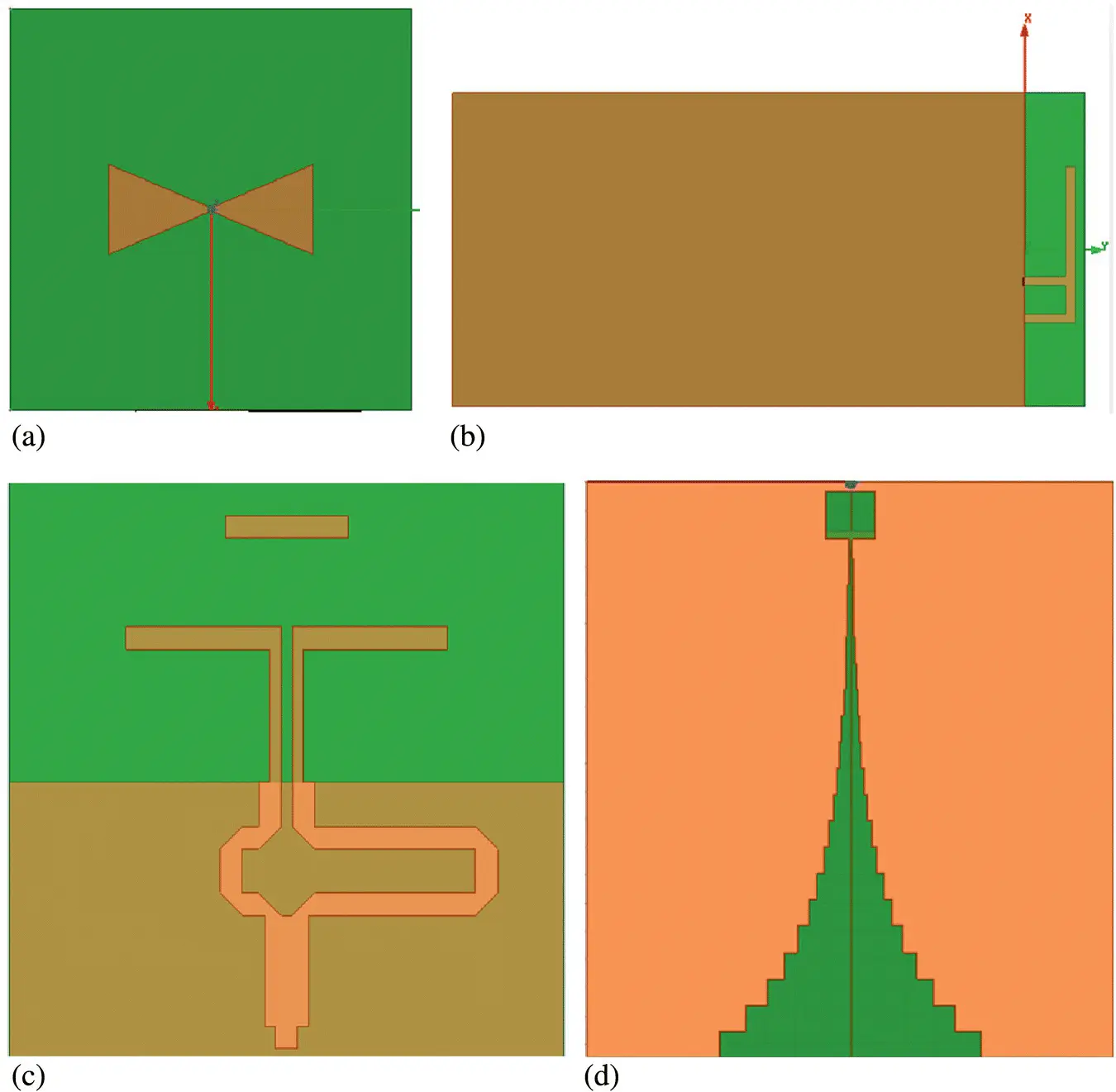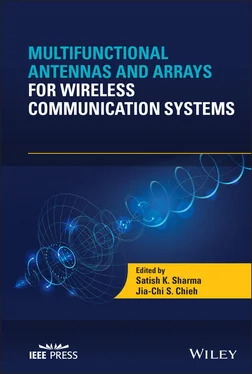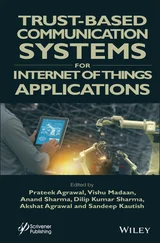We would like to mention that the slight overlap between the content in couple of chapters is acknowledged. We have done this intentionally so that discussion is complete in the respective chapters. While the contributors and authors have made great effort to present details for each topic area, they are by no means complete as the body of work in this field is large. They do represent the interpretations of each chapter’s contributors. As time progresses, further improvements and innovations in the state‐of‐the‐art technologies in reconfigurable antennas is anticipated. Therefore, it is expected that interested readers should continually refresh their knowledge to follow the growth of communication technologies.
Professor Satish K. Sharma, PhDJia‐Chi S. Chieh, PhD
1 February 2021
San Diego, CA, USA
We would like to offer our sincere thanks to the chapter coauthors for their valuable contributions, patience and timely support throughout the development of this book. We would also like to thank the Wiley team members especially, Brett Kurzman, Victoria Bradshaw, Sarah Lemore, Sukhwinder Singh and most importantly S. M. Amudhapriya for their immense help throughout the completion of this book.
Professor Satish K. Sharma will like to take this opportunity to thank his research collaborators, past and present graduate students, post‐doctoral fellows, visiting scholars, and undergraduate students at San Diego State University (SDSU) who have been the continuous source for his research growth. He thanks Dr. Jia‐Chi S. Chieh for agreeing to work on this book. He also thanks the funding agencies: National Science Foundation (NSF) for the prestigious CAREER award, the Office of Naval Research (ONR), the Naval Information Warfare Center‐Pacific (NIWC‐PAC), the Space and Naval Warfare Systems Command (SPAWAR)‐San Diego, and the SBIR/STTR Phase I and II research grants subcontracted through the local industries, which have helped him pursue his research work. Finally, he thanks his spouse Mamta Sharma (Author and Artist) and daughters Shiva Shree Sharma (Doctoral Student in Material Science Engineering at University of California, Riverside, California) and Shruti Shree Sharma (Undergraduate Student in Electrical Engineering at University of California, Irvine, California) who spared their valuable time to let him work on this book and offered their unconditional love and support as always. He also thanks his pet dog and cat Charlie Sharma and Razzle Sharma, respectively, for their unconditional love to him. Lastly, he is grateful to his parents (Mr. Rama Naresh Sharma and Mrs. Taravati Sharma), elders in his extended family, research advisors (Professors L. Shafai, the University of Manitoba and B. R. Vishvakarma, Indian Institute of Technology, Banaras Hindu University), teachers, colleagues, friends and the almighty God for bestowing continuous blessings on him.
Dr. Jia‐Chi S. Chieh is grateful to his research group at the Naval Information Warfare Center in San Diego for their tireless efforts in the development of low‐cost phased array antennas over the last decade. He is also grateful for the research collaboration opportunities he has had with Prof. Satish K. Sharma from San Diego State University (SDSU), as well as his mentorship and friendship over the years. He is thankful to his family for their love and support, and who have allowed him to complete this work including his wife Kristine, and his two daughters Joanna and Audrey. Lastly, he is grateful to his parents (Dr. Shih‐Huang Chieh and Mrs. Dolly Chieh), who taught him the importance of learning and to never stop.
Professor Satish K. Sharma, PhDJia‐Chi S. Chieh, PhD
1 February 2021
San Diego, CA, USA
Satish K. Sharma and Jia‐Chi S. Chieh
In this chapter, we provide basic discussion about an antenna and its importance, type of antennas, and introductory information about the reconfigurable antenna, frequency agile antenna, multifunctional antenna, and antenna measurements.
1.2 Antenna: an Integral Component of Wireless Communications
An antenna is described as a device that radiates or receives transverse electromagnetic waves (TEM) from its surface, or structure. It is an integral component of all the wireless communication systems. As shown in Figure 1.1, the transmitter block which usually consists of the signal generator, modulator, and power amplifiers is terminated with an antenna to radiate the power in free space. A poor choice and design of antenna will result in the power being reflected to the source and cause waste of power, which is undesirable. Efficient power utilization becomes critical in applications such as onboard circuits in satellite communications. To emphasize the importance of antennas for the receiver circuitry, maximum power should be obtained from the incident wave to relax the burden on the succeeding blocks such as low noise amplifiers to maintain the required signal‐to‐noise‐ratio (SNR) for satisfactory wireless links. Different communication application demands different minimum required SNR for a satisfactory link and efficient antenna design plays a big role in achieving this goal.

Figure 1.1 The importance of antenna in a wireless communication system.
1.3 Antenna Performance Parameters
Antenna performance parameters can be categorized into two groups: circuit parameters and radiation parameters. Circuit parameters refer to the impedance matching properties such as reflection coefficient magnitudes (|S ii|) and isolation (|S ij|) between the antenna ports. Antenna radiation parameters refer to radiation patterns, gain, directivity, antenna efficiency, polarization, effective length and effective aperture, antenna temperature, etc. Readers should refer to the well‐known text book by C. A. Balanis, Antenna Theory: Analysis and Design (Fourth Revised edition), Wiley publications [1] for detailed discussion and learning about these antenna performance parameters.
Various antennas that find use in wireless communication systems can be classified in many ways. Antenna geometry of four selected antennas is shown in Figure 1.2. Figure 1.2a shows a well‐known bow‐tie planar antenna that is known for wideband operation with omnidirectional radiation pattern performance. A planar inverted F‐antenna (PIFA) is shown in Figure 1.2b which has been known to provide single and multi‐band operation based on suitable dimension of the radiating structures and feeding mechanism. It also offers omnidirectional radiation patterns. Figure 1.2c shows a quasi‐Yagi planar antenna which offers end‐fire directional radiation patterns. Similarly, Figure 1.2d shows a stepped Vivaldi planar antenna which is known for its extremely wideband antenna performance.
The antenna performance can be characterized using impedance matching and radiation patterns. One example is shown in Figure 1.3. Figure 1.3a shows reflection coefficient magnitude versus frequency and Figure 1.3b shows 3D gain radiation patterns of an antenna. There are numerous full‐wave analysis tools, also called Maxwell Solvers, which provide accurate simulation and analysis results for an antenna. One such tool is Ansys high‐frequency structure simulator (HFSS) which has been used to generate these impedance matching and radiation pattern.

Figure 1.2 Some antenna types generated through Antenna Design Kit in Ansys Electronic Package.
Читать дальше














